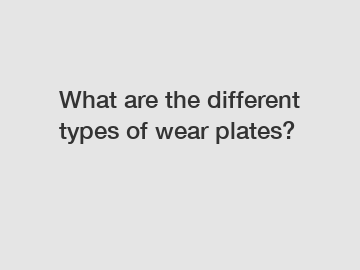Dec. 15, 2023
Mechanical Parts
What are the Different Types of Wear Plates?
Wear plates, also known as liners or wear liners, are protective steel plates that are used to safeguard various industrial equipment from wear and tear. They are designed to protect machinery and reduce maintenance costs by providing a sacrificial layer between the equipment and the abrasive material it comes into contact with. Wear plates offer enhanced durability, prolonging the lifespan of the machinery and reducing downtime. They find applications in industries such as mining, construction, material handling, and agriculture. In this article, we will discuss the different types of wear plates commonly used in various industries.
Abrasion-Resistant (AR) Plates.

One of the most widely used types of wear plates is abrasion-resistant (AR) plates. These plates are composed of a high-carbon alloy steel that exhibits excellent abrasion resistance. AR plates are suitable for harsh working environments where excessive wear and tear are expected. They can withstand heavy impact and resist abrasion caused by factors such as repeated impact, sliding, and scraping. AR plates are commonly used in applications such as dump truck beds, bucket liners, and conveyor systems.
Chrome Carbide Overlay (CCO) Plates.
Chrome carbide overlay (CCO) plates are another popular choice for wear plates. These plates are made by welding a layer of chromium carbide onto a base metal, typically mild steel. CCO plates provide exceptional resistance to abrasion, impact, and corrosion. The chromium carbide layer acts as a barrier, preventing direct contact between the abrasive material and the base metal. CCO plates are commonly used in applications such as chute liners, deflector plates, and wear-resistant parts for mining equipment.
Quenched and Tempered (Q&T) Plates.
Quenched and tempered (Q&T) plates are heat-treated to enhance their hardness and toughness. These plates are made by heating the steel to a high temperature and then rapidly cooling it with water or oil. This process creates a hardened surface layer that provides excellent resistance to wear and impact. Q&T plates have high strength and are suitable for applications that require resistance to both abrasion and impact, such as excavator buckets, ripper shanks, and crusher liners.
Further reading:Ultra-High Molecular Weight Polyethylene (UHMWPE) Plates.
For certain applications where weight and noise reduction are important, ultra-high molecular weight polyethylene (UHMWPE) plates are used. These plates are made from a plastic polymer that exhibits exceptional resistance to abrasion and impact. UHMWPE plates are lightweight, self-lubricating, and have a low coefficient of friction, making them suitable for applications such as conveyor systems, bulk material handling, and skid plates. They are also chemically resistant and can withstand harsh environments.
Ceramic Plates.
Ceramic wear plates are used in applications that require resistance to high temperatures and severe abrasion. These plates are made from ceramics such as alumina, silicon carbide, or boron carbide, which have excellent hardness and heat resistance. Ceramic plates can withstand extreme wear and offer superior protection against abrasive materials. They are commonly used in industries such as mining, steel, power generation, and cement manufacturing.
Conclusion.
Wear plates are essential components in industries that involve abrasive materials and heavy machinery. There are various types of wear plates available, each suited for specific applications and environments. Whether it is AR plates, CCO plates, Q&T plates, UHMWPE plates, or ceramic plates, selecting the right wear plate is crucial for optimizing equipment performance and reducing maintenance costs.
To learn more about wear plates and find the right solution for your specific needs, contact us today. Our team of experts will be happy to assist you in making an informed decision and ensuring the longevity of your equipment.
If you are looking for more details, kindly visit Chromium Carbide Wear Plate, china chrome carbide overlay supplier, what is hardfacing.
Further reading:Previous: How do I choose a direction control valve?
Next: Demystifying Thin Section Tapered Roller Bearings: Revealing Secrets
Related Articles
If you are interested in sending in a Guest Blogger Submission,welcome to write for us!
All Comments ( 0 )